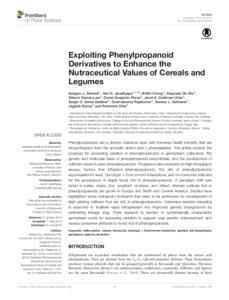Exploiting Phenylpropanoid Derivatives to Enhance the Nutraceutical Values of Cereals and Legumes
Abstract
Phenylpropanoids are a diverse chemical class with immense health benefits that are biosynthesized from the aromatic amino acid L-phenylalanine. This article reviews the progress for accessing variation in phenylpropanoids in germplasm collections, the genetic and molecular basis of phenylpropanoid biosynthesis, and the development of cultivars dense in seed-phenylpropanoids. Progress is also reviewed on high-throughput assays, factors that influence phenylpropanoids, the site of phenylpropanoids accumulation in seed, Genotype × Environment interactions, and on consumer attitudes for the acceptance of staple foods rich in phenylpropanoids. A paradigm shift was noted in barley, maize, rice, sorghum, soybean, and wheat, wherein cultivars rich in phenylpropanoids are grown in Europe and North and Central America. Studies have highlighted some biological constraints that need to be addressed for development of high-yielding cultivars that are rich in phenylpropanoids. Genomics-assisted breeding is expected to facilitate rapid introgression into improved genetic backgrounds by minimizing linkage drag. More research is needed to systematically characterize germplasm pools for assessing variation to support crop genetic enhancement, and assess consumer attitudes to foods rich in phenylpropanoids

